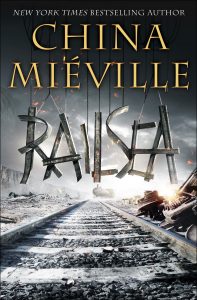I apologize for the hiatus—I know it’s been a while. The good news is that I’ve haven’t been posting because a series of exciting adventures have struck: the whole pregnancy thing (only five weeks until the little guy comes!), moving back to Utah from Texas, and starting graduate school are just a few of them. Because of all the adventures, after the next three book reviews (this one included), I’m only going to post once a week, on Wednesdays, instead of the Monday-Wednesday-Friday schedule I used to have. Now, speaking of adventures, here’s a look at China Miéville’s latest work: Railsea.

On board the moiletrain Medes, Sham Yes ap Soorap watches in awe as he witnesses his first moldywarpe hunt: the giant mole bursting from the earth, the harpoonists targeting their prey, the battle resulting in one’s death & the other’s glory. But no matter how spectacular it is, Sham can’t shake the sense that there is more to life than traveling the endless rails of the railsea—even if his captain can think only of the hunt for the ivory-colored mole she’s been chasing since it took her arm all those years ago. When they come across a wrecked train, at first it’s a welcome distraction. But what Sham finds in the derelict—a kind of treasure map indicating a mythical place untouched by iron rails—leads to considerably more than he’d bargained for. Soon he’s hunted on all sides, by pirates, trainsfolk, monsters & salvage-scrabblers. & it might not be just Sham’s life that’s about to change. It could be the whole of the railsea.
A Unique Spin on Classic Stories
As you may have guessed from the book description, Railsea bears traces of Moby Dick in it, only instead of hunting a great white whale, the crew of the Medes is hunting an ivory mole (the captain is certain to inform anyone who thinks otherwise that Mocker Jack is not yellow). But as I read, I found that the actual plot line bears a stronger resemblance to Treasure Island. Young Sham longs for adventure and finds a bit too much of it along his way.
However, as one would expect of Miéville, although the book draws on these classic stories, it has a texture and a feeling that is all its own. The dingy, polluted atmosphere of the world of the railsea permeates the book and makes it settle into your mind even when the scenes are on the lighter side. The worldbuilding is in depth and shows itself in everything from the way the world’s inhabitants think about dirt and water to the way the words appear on the page (the word “and” is never used, only the ampersand). Railsea’s world is, well, not necessarily a delight, but certainly a unique draw for the book. (I can’t use delight because that implies sunshine and butterflies, but between the polluted cloud of the upsky and the bizarre mutations it causes for airborne creatures, you find little of either on the railsea.)
A Lackluster Main Character
Although the setting was compelling, I found it difficult to read Railsea quickly (quite the change from how I felt about Embassytown). This was largely because the main character, Sham, didn’t particularly interest me. He is a young boy without much direction in life: he longs for some kind of purpose, but since he doesn’t know what he wants, he simply drifts from task to task and from event to event. That attitude doesn’t really change until at least halfway through the book, and by that time I’d failed to connect with him. This stands in stark contrast with Avice from Embassytown, who was a self-proclaimed societal drifter, but who was compelling anyway. However, like Avice, Sham changes a lot over the course of the book, and his growth is realistic. He just isn’t as compelling.
Final Thoughts
Outside of the main character issue, I think the book was particularly strong. I enjoyed the stylistic prose quirks—the self-aware narrator, the asides about storytelling, etc.—even when they interrupted the flow of the narrative. Speculative fiction is prone to info dumps, and many people hate them (myself included) as a general rule. But in Railsea, Miéville selectively info dumps in a few chapters, never taking more than a page or two at a time. The voice is so compelling that the info dumps don’t feel like info dumps, and the timeouts from the main plot were some of my favorite parts of the book.
Content warnings: Some violence, though it isn’t trivialized; some language, though nothing you wouldn’t hear on TV; drinking; sideways conversations about sex, but no sexual scenes.




Leave a Reply